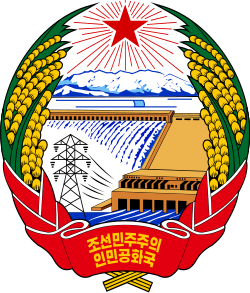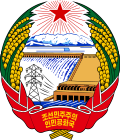Cabinet of North Korea
 From Wikipedia - Reading time: 15 min
From Wikipedia - Reading time: 15 min
 | |
| Government overview | |
|---|---|
| Formed | 1948 |
| Jurisdiction | North Korea |
| Headquarters | Pyongyang |
| Government executives |
|
| Website | Minju Choson, the official newspaper of the Cabinet |
 |
|---|
|
|
The Cabinet of Democratic People's Republic of Korea (Korean: 조선민주주의인민공화국 내각; Hanja: 朝鮮民主主義人民共和國 內閣) is the supreme administrative organ of North Korea and the executive organ of the Supreme People's Assembly, the highest organ of state power.[1] The Cabinet's official newspaper is Minju Choson.
History
[edit]
In North Korea's first constitution, adopted in 1948, the executive powers were vested in the Cabinet, chaired by Kim Il Sung himself.
The 1972 constitution saw the establishment of the post of President of North Korea which led the executive branch, and the cabinet was split into two organizations: The Central People's Committee (Korean: 중앙인민위원회) and the State Administration Council (Korean: 정무원). The Central People's Committee provided the highest visible institutional link between the party and the government and served in effect as a de facto super-cabinet. According to the 1972 constitution, the Central People's Committee, chaired by President of North Korea, exercised wide range of powers such as shaping the internal and external policies of the state, direct the work of the Administration Council and provincial people's committee, supervising the execution of the constitution, laws and ordinances of the Supreme People's Assembly, establish or abolish ministries, executive bodies of the Administration Council and appoint or remove vice premiers, ministers and other members of the Administration Council and also to declare a state of war and enacting mobilization orders in case of emergency. Article 104 gave the authority to the CPC to adopt decrees and decisions and issue directives.[2] The National Defence Commission was then one of the sub-committees of this body.[3]
The State Administration Council was guided by the CPC and was led by a premier (chong-ri) and included vice premiers (bochong-ri), ministers (boojang), committee chairmen, and other cabinet-level members of central agencies. It was responsible for the formulation of state economic development plans and measures for implementing them, the preparation of the state budget, and the handling of other monetary and fiscal matters.[4]
1982 saw the People's Armed Forces and Public Security Ministries assigned directly to the President together with the State Inspection Commission.
In 1990, by a CPC decision, the National Defense Commission became fully independent from it as a separate institution, and 1992 constitutional amendments assigned it directly to the Supreme People's Assembly. In 1998 amendments to the Constitution, the Central People's Committee and the State Administration were abolished, and the Cabinet was re-created. Thus, the Cabinet is not only the highest administrative and executive organ but was also expanded to become the general State management organ.
Emphasizing its expanded role, in January 1999 Kim Jong Il stated that
"The party organizations and party cadres should not intervene in administrative matters. The party should help the cabinet to be responsible for all economic affairs. Last year we made a new governmental system where the cabinet is supposed to be the control tower of the economy...No organizational unit should handle economic problems without consulting the cabinet".[5]
Selection
[edit]The cabinet is appointed and accountable to the Supreme People's Assembly, the North Korean unicameral parliament. The SPA chooses the Premier of North Korea who appoints three vice premiers and the cabinet's ministers. All members of the cabinet are members of the Workers' Party of Korea which rules the country since its establishment in 1948. While the SPA is not in session, the cabinet is accountable to the Presidium of the Supreme People's Assembly.[6]
As of 2000[update], some 260 people have served as cabinet ministers. Six of them have been women:[7] Ho Jong-suk (Minister of Culture, Justice), Pak Chong-ae (Agriculture), Yi Yang-suk (Commerce, Textile and Paper Industries), Pak Yong-sin (Culture), Yi Ho-hyok (Foodstuff and Daily Necessities Industries), and Yun Gi-jong (Finance).[8]
Powers and responsibilities
[edit]The Cabinet, as the executive branch of the North Korean state, is responsible for implementing the state's economic policies, as guided by the Workers' Party. The cabinet is not responsible for defense and security issues, as those are handled by the State Affairs Commission. Thus, the security organizations such as the Korean People's Army, Ministry of Social Security and State Security Department report and subordinated directly to the SAC, whose chairman holds full power as the supreme leader of the republic and the party and overall commander-in-chief of all uniformed forces.[9] The Cabinet convenes a plenary meeting and an executive meeting.[10] The plenary meeting consists of all the Cabinet members, while the executive meeting is kind of a presidium, and comprises fewer people, including the Premier, vice premier and other Cabinet members whom the Premier nominates. The cabinet acts in the form of decisions and directives.[11] In the performance of its mandate the Cabinet is empowered by the Constitution to:[12]
- adopt measures to execute state policy.
- institute, amend, and supplement regulations concerning state management based on the Constitution and ministerial laws.
- guide the work of the Cabinet commissions, ministries, direct ministries and subordinate agencies of the Cabinet and the local people's committees
- set up and remove direct ministries and agencies, main administrative economic organizations, and enterprises, and adopt measures to improve the State management structure.
- draft the State plan for the development of the national economy and adopt measures to put it into effect.
- compile the State budget and adopt measures to implement it.
- organize and exercise works in the fields of industry, agriculture, construction, transportation, communications, commerce, trade, land management, city management, education, science, culture, health, physical training, labor administration, environmental protection, tourism and others.
- adopt measures to strengthen the monetary and banking system.
- do inspection and control work to establish a state management order.
- adopt measures to maintain social order, protect State and social cooperation body's possession and interests, and to guarantee citizens’ rights.
- conclude treaties with foreign countries, and conduct external activities.
- abolish decisions and directions by economic administrative organs, which run counter to the decisions or directions made by its members.
Those Cabinet ministries that oversee economic sectors also control groups of industries called "complexes". These complexes consist of partially or fully state-owned industrial facilities like factories, mines, or farms, depending on the sector.[13] At a local level, the Cabinet supervises the Local People's Committees.
Structure
[edit]This section includes a list of general references, but it lacks sufficient corresponding inline citations. (August 2022) |
As of 28 September 2023[update], the Cabinet consists of the following:[14][15][16][17][18][19][20]
See also
[edit]References
[edit]- ^ "The World Factbook". Central Intelligence Agency: Korea, North. 1 May 2018. Retrieved 9 May 2018.
- ^ Dae-Sook Suh & Chae-Jin Lee. Political Leadership in Korea. The 1972 Constitution and Top Communist Leaders, p. 197
- ^ Article 105 of the 1972 Constitution
- ^ A Country Study: North Korea- 1993- Library of Congress
- ^ Jae-Cheon Lim. Kim Jong-il's Leadership of North Korea, p. 116
- ^ Article 125 of the Constitution of North Korea
- ^ Lankov, Andrei (2015). The Real North Korea: Life and Politics in the Failed Stalinist Utopia. Oxford: Oxford University Press. p. 28. ISBN 978-0-19-939003-8.
- ^ Park, Kyung Ae (1994). "Women and Revolution in South and North Korea". In Tétreault, Mary Ann (ed.). Women and Revolution in Africa, Asia, and the New World. Columbia: University of South Carolina Press. p. 182. ISBN 978-1-57003-016-1.
- ^ Articles 100 and 103 of the Constitution of North Korea
- ^ Article 127 of the Constitution of North Korea
- ^ Article 129 of the Constitution of North Korea
- ^ Article 125 of the Constitution of North Korea
- ^ Madden, Michael (16 January 2019). "The DPRK Political Season: Two Post-Mortems". 38 North. Retrieved 19 January 2019.
- ^ "Members of DPRK Cabinet Appointed". KCNA Watch. 18 January 2021.
- ^ "Report on 5th Plenary Meeting of 7th C.C., WPK". KCNA Watch. 1 January 2020.
- ^ "Press Release of 8th Congress of WPK". KCNA Watch. 11 January 2021.
- ^ "North Korea picks army man who led Korean talks as top envoy". The Straits Times. Bloomberg. 19 January 2020. Retrieved 19 January 2020.
- ^ "Kim Jong Un sacks foreign minister, says report". Financial Times. 19 January 2020. Retrieved 2020-01-19.
- ^ Johnson, Jesse (2020-01-19). "North Korea ditches top diplomat in reshuffle that could impact nuclear talks". The Japan Times Online. ISSN 0447-5763. Retrieved 2020-01-19.
- ^ "In full: promotions and demotions at North Korea's 14th SPA". NK PRO. Korea Risk Group. 12 April 2019. Retrieved 17 April 2019.
- ^ a b c d Sokolin, Anton (29 December 2024). "North Korea adopts 'most hardline' stance against US ahead of Trump presidency". NK News. Retrieved 29 December 2024.
- ^ "N. Korea appoints veteran diplomat as first female foreign minister". France 24. 2022-06-11. Retrieved 2023-10-01.
- ^ a b "North Korea appoints first female Foreign Minister". THE VOICE OF VIETNAM. 2022-06-11. Retrieved 2023-10-01.
- ^ a b c d e "Members of DPRK Cabinet Newly Appointed". Rodong Sinmun. 28 September 2023. Retrieved 28 September 2023.
- ^ "North Korea's Ministry of Posts and Telecommunications has been renamed the Ministry of Information Industry". 27 September 2021. Retrieved 20 December 2024.
- ^ "North Korea's Ministry of Electronics Industry also merged into the Ministry of Information Industry". 1 December 2021. Retrieved 20 December 2024.
- ^ a b "조선민주주의인민공화국 최고인민회의 제14기 제11차회의 진행" [The 11th Session of the 14th Supreme People's Assembly of the Democratic People's Republic of Korea]. Korean Central News Agency. 9 October 2024. Retrieved 9 October 2024.
- ^ Yuna, Ha (2021-07-08). "The reason why the president of Kim Il Sung University was replaced recently | Daily NK English". Retrieved 2023-10-01.
 KSF
KSF

